Timeline - 1800s
BATTEL OF ASSAYE
1803
Five thousand British troops under command of Sir Arthur Wellesley, later the Duke of Wellington, took on the Mahratta’s forty-two thousand-strong army at the Battle of Assaye. The 74th Highlanders defended the position alongside The 78th Highlanders, The 19th Light Dragoon and various battalions of Sepoys; holding the ground with heavy losses.
Read More
THE MAHRATTA WAR
1802-05
The 74th was present, under Sir Arthur Wellesley, (later Lord Wellington) throughout the campaign and took part in the battles of Ahmednaggar (1803), Assaye (1803), Argaum (1803), Gwalighur (1803) and others. The 74th returned home in 1805, having been awarded the Assaye Colour, the insignia of the elephant on the Regimental Colour and having been descibed by Sir Arthur Wellesley as ‘My fighting Regiment’. Later the Regiment became known as ‘The Assaye Regiment’ for its epic stand at the battle.
SOUTH AFRICA
1805-06
71st at assault landing at the Cape of Good Hope and the battle of Blauberg (1806). The Cape of Good Hope was thus taken from the Dutch.
SOUTH AMERICA
1806-07
71st in assault and capture of Buenos Aires. Later surrendered with Honours of War, when the British Government decided not to support the expedition, thus giving the Regiment no alternative but to surrender. Returned intact to England in 1807.
NAPOLEONIC WARS – SICILY – EGYPT – ITALY – PONZA
1806-14
1/21st based on Sicily to protect the island against the French.Joined the expedition to Egypt (1807). Fought in Italy (1809). Repulsed French attacks on Sicily (1810). Grenadier company landed at Alicante, Spain (1811). Two companies landed on the island of Ponza (1813). Advanced through Italy (1814) and was present at the fall of Genoa (1814). Thereafter embarked for America
1804-16
2/21st after being stationed in Scotland and Ireland (1804-1813) crossed to the continent (1813) and took part in the battle of Bergen-op- Zoom (1814). Returned to Scotland (1815) and disbanded (1816).
FIRST PENINSULAR CAMPAIGNS
1808-09
First Peninsular campaign under Sir Arthur Wellesley and later, under Sir John Moore. The 71st was present throughout , and took part in the battles of Rolica (1808), Vimiera (1808), Corunna (1809) . The Regiment was part of the rearguard action during the retreat to Corunna.
71st BECOME LIGHT INFANTRY
1809
On 22nd March 1809, the 71st were designated Light Infantry being styled the 71st (Highland Light Infantry ) Regiment. This was a mark of esteem as the Light Infantry regiments were regarded as a crack corps, trained to fight in open order with great emphasis on the intelligence and spirit of the ordinary soldier.
WALCHEREN
1809
The 71st took part in the Walcheren Expedition of 1809 and were in action at the capture of Veer and Flushing.
SECOND PENINSULAR CAMPAIGN
1810-14
The 74th arrived in the Peninsula in January and the 71st in May 1810. Both Regiments were present throughout the remainder of the campaign until Napoleon abdicated in 1814. One or other, or both, were present at every major action except Albuera and Talavera.
They fought in many battles including:-
71st
Sobral (1810) Fuentes D’Onor (1811) Arroyo des Molinos ( 1811) Almaraz (1812) Vittoria (1812) Maya (1813) Pyrenees (1813) Nive (1813) Orthes (1814) Aire (1814)
74th
Busaco (1810) Fuentes D’Onor (1811) Cuidad Rodrigo (1812) Badajoz (1812) San Christobal (1812) Salamnca (1812) Vittoria (1812) Pyrenees (1812) Nivelle (1813) Orthes (1814) Toulouse (1814)
In all these battles, the Regiments played a distinguished part but the 71st’s conduct in the battle earned them the title of ‘The Heroes of Vittoria’, and the 74th’s part in the storming of Badajoz had a profound effect on the course of the war. No other Regiment had more Peninsular War Battle Honours on its Colours.
SIEGE OF BADAJOZ
1812
The siege of Badajoz was one of the most formidable operations in the history of warfare!
By their action in the capture of Badajoz, one of the most formidable fortresses in Europe, The 74th ensured that British communication and supplies continued into Spain during the Peninsular War.
Read More
BATTLE OF BLADENSURG
1814
Adventures in the War of 1812 – Almost capturing President James Madison, Secretary of War and other members of Federal Government, the 21st marched unobstructed into the capital of the U.S.A, eating the Presidential banquet and burning down the famous White House.
Read More
BATTLE OF WATERLOO
1815
Sustaining artillery fire, cavalry charges, driving back the Imperial Guard and firing the last shot a Waterloo! The 71st Highlanders were in the thick of the battle of Waterloo.
Assigned to Adam’s Light Brigade, The 71st endured over two hours of intense artillery fire leaving many dead and wounded on the ground. Following this they then repulsed seven cavalry charges, during one of which the Duke of Wellington, attended only by his trumpeter, took refuge in their square.
THE WAR WITH AMERICA
1814-15
The 1/21st was part of the force which defeated American troops at Bladensburg (1814) and entered Washington, where the Regiment ate the Presidential banquet prepared to celebrate its defeat. Later the 21st was in action at Baltimore (1814) and New Orleans (1815), and returned to Europe, joining Wellington’s Army, after peace was declared in 1815.
THE LONG PEACE
The forty years between Waterloo and the Crimea were known as ‘the long peace’ but there were riots in England, rebellion in Ireland ,whilst the British Empire required considerable attention. During this period , the Regiments served as follows:-
21st
Army of Occupation, France 1816 : England 1817-18 : West Indies 1819-26 : England and Ireland 1827-32 : Australia, in charge of convicts 1833-38 : India 1839-47 : England, Scotland and Ireland 1843-53.
1/71st
Army of Occupation, France 1815-17 : England and Ireland 1818-23 : Canada 1824-30 : Bermuda 1831-33 : Scotland and Ireland 1834-37: Canada, suppressing rebellion and preventing American infiltration attempts 1838-42 : West Indies 1843-46 : England, Scotland and Ireland 1847-52 : Corfu 1853-54.
2/71st
Re- raised 1842 – Canada 1843-54 – Amalgamated with 1/71st 1855.
74th
Ireland 1814-18 : Canada and Bermuda 1818-29 : Ireland 1830-33: West Indies 1834-40 : Canada 1841-44 : England, Scotland and Ireland 1845-50 : South Africa 1851-53 : East Indies 1853.
1851-53
The 74th arrived in South Africa in 1851 and campaigned for three years against the Kaffirs, sustaining fairly heavy casualties. The major actions fought included Amatola Heights (1851) and the Waterkloof (1851). The war finished with the defeat of the tribes and the establishment of Basutoland as a Protectorate. The battle honour, South Africa 1851-2-3 was awarded.
During the war, in 1852, the transport Birkenhead carrying reinforcements was wrecked and sank. The senior officer and largest draft aboard were the 74th and the courage and discipline displayed by the soldiers, under the orders of Lt. Col. Alexander Seton, 74th, aroused the world’s admiration.
HMS BIRKENHEAD
1852
HMS Birkenhead, carrying reinforcements for the Kaffir War in South Africa, struck rocks off the coast of Simonstown and sank 25 minutes later. It is the first recorded incident of “Women & Children First” or The Birkenhead Drill.
Colonel Seton, ordered his men of The 74th Highlanders and other regiments to stand fast so that the women & children could use the available boats – out of a company of 631 on board the ship, only 193 (including all the women & children) were saved.
Read More
THE CRIMEA
1853-56
In 1853 Russia declared war on Turkey, and Great Britain and France intervened on the side of the latter. An Anglo- French force was despatched to the Crimea. It included the 21st which took part in the victory on the Alma and in the battle of Inkerman , where it made an heroic stand on a position on the Inkerman Heights known as ‘ The Barrier’. The 1/71st from Corfu and 2/71st from Canada arrived in the Crimea in 1855, where they were amalgamated. Both the 21st and 71st served in the trenches before Sevastopol (1854) during the long seige and subsequently at its capture. The 71st was later engaged in operations on the Kerch Peninsula. Peace was declared in 1856 after a war notorious for the privations inflicted on the troops who took part.
MALTA
1856-60
1/21st on garrison duties in Malta.
1856-57
71st also on garrison duties in Malta.
THE INDIAN MUTINY
1854-57
The 74th arrived in India from the East Indies in 1854 and remained on garrison duties until 1857 when the Indian Mutiny broke out. The Regiment took part in general operations throughout the period and shared the battle honour Central India with the 71st.
1858-59
The 71st arrived in India in 1858. They took part in numerous actions particularly at Koonch (1858) and Morar, where the first VC was won by Private George Rogers .
Pte G Rogers VC
1858
Private George Rogers of The 71st Highlanders was awarded the Victoria Cross for “daring conduct” at Batttle of Marar (1858) in the Indian Uprising.
Read More
GARRISON DUTY
1859-64
After the Mutiny ended in 1859, both the 71st and the 74th remained in India on garrison duty – the 71st until 1863 and the 74th until 1864.
1864-66
The 74th then returned to Scotland and was situated in Britain until 1866.
1860-96
Meanwhile the 1/21st had embarked for the West Indies from Malta in 1860 and remained there until 1864, when it returned to Britain, occupying various stations in Scotland, England and Ireland from 1864 to 1868. In 1869 it arrived in India where it remained until 1881 when it returned to Britain and was stationed in England and Ireland until 1895.Returned to India in 1896. In 1877 the Battalion had become the 1st Battalion Royal Scots Fusiliers (1 RSF ) on the authorisation of the old title.
1858-79
The 2/21st was re-raised in Paisley in 1858 and was stationed in Wales, England and Ireland until 1862, before embarking for India and remaining there until 1868. From here the Regiment was transferred to Burma (1868-71) thereafter returning to India. When relieved by the 1/21st it returned home in 1873, serving in Scotland, England and Ireland until 1879, when it embarked for South Africa.In 1877 its title was changed to 2nd Royal Scots Fusiliers (2 RSF)
1863-81
After the Umbeyla Campaign (1863-64), referred to later, the 71st was stationed in England, Scotland and Ireland (1865-67). Later it served in Gibraltar (1868-73), Malta (1873-78), Cyprus (1878), Gibraltar (1878-80). It returned to Scotland in 1881, when it became the 1st Battalion, The Highland Infantry (1HLI ).
1864-81
The 74th was stationed in Scotland, England and Ireland from 1864-66 : it then garrisoned Gibraltar (1867-72) : Malta (1872-75) : the Straits Settlements(1876-78) : Hong Kong (1879) : Singapore (1880), then back to Scotland and England (1880-81) when it became the 2nd Battalion, The Highland Light Infantry (2HLI).
UMBEYLA
1863-64
The 71st took part in the Umbeyla Campaign on the North West Frontier of India,culminating in the capture, by the Regiment, of Crag Picquet against heavy odds.
SOUTH AFRICA
1879
2 RSF took part in the Zulu War, marching into Zululand to retrieve the disaster of Isandlwana. The Colours were carried into action for the last time at the battle of Ulundi where Cetawayo was defeated.
The battle honour South Africa 1879 was awarded.
THE BOER REBELLION
1880-82
In 1880 the Boers rose in a revolt which ended in the cession by Britain of the Transvaal. In these difficult circumstances. 2 RSF played a notable part including the defence of Potchefstroom for four months. The Battalion moved to India in1882.
Tel-el-Kebir
1882
Tel-el-Kebir was a battle fought during the Anglo-Egyptian War.
Tel-el-Kebir had two weaknesses in this otherwise formidable position. The first was that the majority of the defences were incomplete, and the second that the frontage was too great for the force which Arabi Pasha had at his disposal, which as far as could be ascertained at the time, amounted to not more than twenty-five thousand of all arms.
Read More
EGYPT
1882-83
In 1882 Arabi Pasha, an Egyptian Army Colonel, headed a revolt against the ruler, Khedive, who was supported by Great Britain. Troops including the 2 HLI were landed at Alexandria. The Battalion took part in the battles of Ramleh and Tel el Kebir , afterwards being among the first troops to enter Cairo, where it received the surrender of the Citadel. The Battalion returned to England in 1883.
BURMA
1883-96
In 1884 the cruelties and intrigues of Thibaw, King of Upper Burma, led to the annexation of the whole country by Britain. 2 RSF took part in the operations and gained the battle honour BURMA 1885-87. Thereafter the Battalion returned to India and remained on garrison duty until 1896.
THE MALAKAND FIELD FORCE
1897-98
Both 1RSF and 2 HLI served with the Malakand Field Force during its operations on the North-West Frontier of India. The battle honour TIRAH was awarded to 1RSF.
1898-1914
Subsequently, 1 RSF remained in India until 1909 and 2 HLI returned to England, remaining there until 1914.
CRETE
1881-99
1 HLI having been stationed in England from 1881 to 1895, and Malta from 1895 to 1898, served in Crete as part of an international force during the rioting of 1898. The Battalion was heavily engaged and suffered a good many casualties. It returned to England in 1899.
1899
Corporal Shaul was awarded the Victory Cross for conspicuous bravery at the Battle of Magersfonteyn in 1899 during the Boer War.
Read More
THE SOUTH AFRICAN WAR
1899-1902
In 1899 the Boer republics declared war on Great Britain and invaded Natal. 2 RSF in the Fusilier Brigade and 1 HLI in the Highland Brigade arrived in South Africa in November 1899. The former Brigade was directed on Kimberley, the latter on Ladysmith which was under seige.
1HLI took part in the battles of Belmont (1899), Modder River (1899), Magersfontein (1899) and several others.
2RSF fought at Colenso (1899), the Relief of Ladysmith (1900) and in other battles.The relief was the turning point of the war, which then turned into a series of guerilla operations in which both Battalions played their part, taking part in innumerable operations.
Opening times
We are open Tuesday - Friday 10:00 - 15:30. We are closed over Christmas and New Year.
Admission
Entry to the museum is FREE although donations are most welcome. If you are bringing a larger groups it's best to let us know in advance.
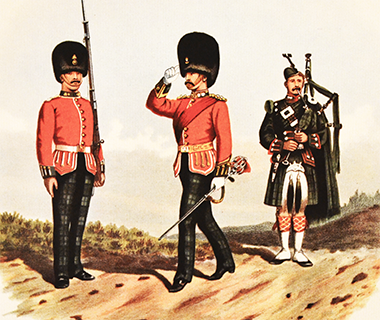
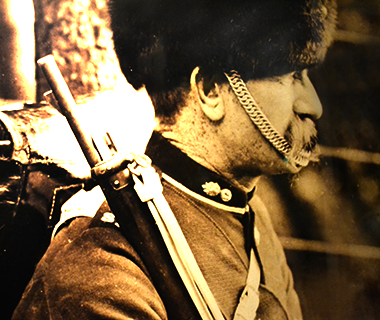
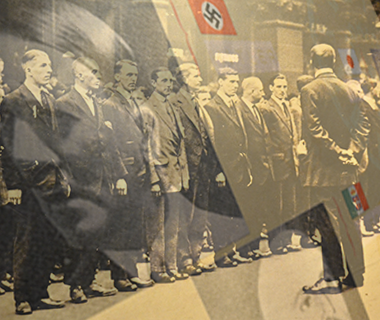
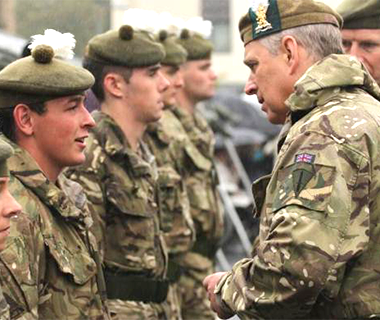
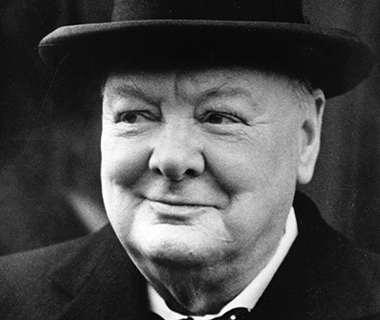
Get in Touch
- call us
0141 332 5639
- our address
518 Sauchiehall Street, Glasgow, G2 3LW, Scotland
